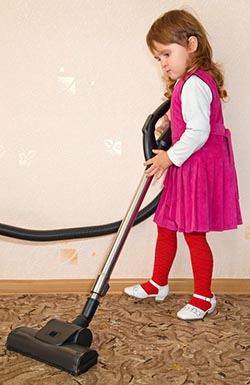 Ever feel overwhelmed? It’s OK—go ahead and admit it! All homeschool moms know what it’s like on
“those” days. Planning, organizing, supervising, and teaching take tremendous energy and plenty of time. Add
house cleaning and cooking to the mix, and the job can utterly exhaust even the most energetic mom.
Ever feel overwhelmed? It’s OK—go ahead and admit it! All homeschool moms know what it’s like on
“those” days. Planning, organizing, supervising, and teaching take tremendous energy and plenty of time. Add
house cleaning and cooking to the mix, and the job can utterly exhaust even the most energetic mom.
Fortunately, help is available! When we parents feel like we can’t go another day without some assistance, maybe
it’s time for us to enlist our own children. Adults often underestimate just how much kids can help.
I learned this first-hand when I took my mother-in-law’s advice to “start them on chores when they’re
young.” True, I could have picked up all the LEGO bricks myself in a fraction of the time it took two-year-old
Eric. I also felt guilty, sometimes, that I couldn’t seem to handle all the responsibilities alone. But most of
the time I tried to let my firstborn tackle the small messes himself. I kept telling myself it would be worth it some
day.
And it was. By the time Eric, Christian, and Lisa were six, four-and-a-half, and two, we’d started scheduling
pick-up three times a day, about 15 minutes before lunch, dinner, and bedtime reading. That way, the children were
motivated to do their jobs both quickly and thoroughly, especially since they knew Mom would be checking.
We also taught them to cook. Four-year-old Mary loved to “do dishes,” standing on a chair next to the sink,
wearing an apron, and rinsing plastic utensils and bowls (which I later re-washed). Soon she took an interest in meal
preparation. She helped tear lettuce pieces for salads. She scooped sugar and kneaded bread dough with her chubby little
fists.
My older kids got involved with kitchen work, too. Junior Chef #1 helped me in the morning with a job such as mixing dry
ingredients for muffins. Junior Chef #2 assisted 15 minutes before dinner, setting the table and preparing a fruit
salad. The system held me accountable for meal-planning and helped our kids learn basic culinary skills.
By the time Eric, Christian, Lisa, and Mary were all homeschooling, I needed apprentices to share the daily workload.
Together we devised a chore chart that looked like this:
- Eric: Lunch dishes, later put away
- Christian: Dinner dishes, a small miscellaneous chore
- Lisa: Junior Chef #1, sweeping the kitchen floor after dinner
- Mary: Dinner dishes put away (from the night before), Junior Chef #2
Each child had one morning or lunchtime job and one evening job. We alternated pairs of chores daily. This isn’t
the only option, of course! I’ve heard of families who assign a child a job for a week, or even longer, or who
tackle all the work together in one block of time each day.
In addition to daily jobs, Michael and I wanted our children to learn how to deep-clean the house and keep the yard in
good condition. For several years, every Monday afternoon we paid our kids a few dollars to clean the house, alternating
between dusting, bathroom cleaning, vacuuming, and one other miscellaneous job. We also kept a list of projects and
assigned them as needed. We were strict. If a kid slopped through his work, he had to redo it—with no pay.
Our system was never perfect. We had to deal with sour attitudes, half-hearted effort, and outright defiance
because—let’s face it—everybody gets sick of chores sometimes. Through trial and error and lots of
missteps, Michael and I fine-tuned the system to discover what worked for us. As a result, our kids learned to keep the
house neat, to cook, and to handle a wide variety of home maintenance chores and yard work.
Eric, Christian, Lisa, and Mary learned perseverance and the value of hard work, which transferred to future jobs. I got
the help I needed day-to-day, freeing up countless hours for homeschooling and paid work. It was a win/win situation for
all of us.